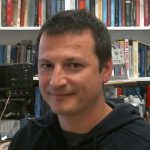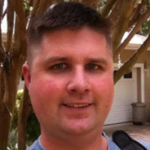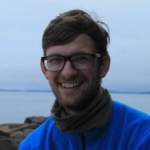People
Ronald G. Driggers
 R. Driggers is a Professor at the University of Arizona’s Wyatt College of Optical Sciences and works in the area of electro-optical and infrared imaging systems. Previously, he was appointed to the Senior Executive Service as the Superintendent of the Optical Sciences Division at the Naval Research Laboratory in 2008. Before 2008, he was the Director of the Modeling and Simulation Division at the U.S. Army’s Night Vision and Electronic Sensors Directorate (NVESD) and a brief period as the Chief of the Electro-Optics and Photonics Division at the Army Research Laboratory. Dr. Driggers received a doctorate in electrical engineering from the University of Memphis in 1990, is the author of five books on Infrared and Electro-Optics Systems. He was Editor-in-Chief of the Encyclopedia of Optical Engineering (Taylor and Francis). He was selected as the 2002 Army Materiel Command’s Engineer of the Year, 2001 CERDEC Technical Employee of the Year, and 2001 NVESD Technical Employee of the Year. He is a retired U.S. Naval Reserve Officer and was selected as the 2001 Naval Engineering Duty Officer of the Year (William Kastner Award). He is also a Fellow of the International Society for Optical Engineering, the Optical Society of America, and the Military Sensing Symposium. He has been the Editor-in-Chief of SPIE’s flagship journal, Optical Engineering, and the Editor-in-Chief of the Optical Society of America’s journal Applied Optics.
R. Driggers is a Professor at the University of Arizona’s Wyatt College of Optical Sciences and works in the area of electro-optical and infrared imaging systems. Previously, he was appointed to the Senior Executive Service as the Superintendent of the Optical Sciences Division at the Naval Research Laboratory in 2008. Before 2008, he was the Director of the Modeling and Simulation Division at the U.S. Army’s Night Vision and Electronic Sensors Directorate (NVESD) and a brief period as the Chief of the Electro-Optics and Photonics Division at the Army Research Laboratory. Dr. Driggers received a doctorate in electrical engineering from the University of Memphis in 1990, is the author of five books on Infrared and Electro-Optics Systems. He was Editor-in-Chief of the Encyclopedia of Optical Engineering (Taylor and Francis). He was selected as the 2002 Army Materiel Command’s Engineer of the Year, 2001 CERDEC Technical Employee of the Year, and 2001 NVESD Technical Employee of the Year. He is a retired U.S. Naval Reserve Officer and was selected as the 2001 Naval Engineering Duty Officer of the Year (William Kastner Award). He is also a Fellow of the International Society for Optical Engineering, the Optical Society of America, and the Military Sensing Symposium. He has been the Editor-in-Chief of SPIE’s flagship journal, Optical Engineering, and the Editor-in-Chief of the Optical Society of America’s journal Applied Optics.
Collaborators
Dr. Gerald Holst
 Gerald Holst is an independent consultant for imaging system analysis and testing. He was a technical liaison to NATO, research scientist for DoD, and a member of the Lockheed-Martin senior technical staff. Dr. Holst has chaired the SPIE conference Infrared Imaging Systems: Design, Analysis, Modeling and Testing since 1989. He is author of over 30 journal articles and 6 books (published by SPIE and/or JCD Publishing). Dr. Holst is a member of OSA and is a SPIE Fellow. Dr. Holst has been collaborating with R. Driggers for over 30 years and has supported the infrared group for 5 years.
Gerald Holst is an independent consultant for imaging system analysis and testing. He was a technical liaison to NATO, research scientist for DoD, and a member of the Lockheed-Martin senior technical staff. Dr. Holst has chaired the SPIE conference Infrared Imaging Systems: Design, Analysis, Modeling and Testing since 1989. He is author of over 30 journal articles and 6 books (published by SPIE and/or JCD Publishing). Dr. Holst is a member of OSA and is a SPIE Fellow. Dr. Holst has been collaborating with R. Driggers for over 30 years and has supported the infrared group for 5 years.
Dr. Holst has been working with Ron Driggers for over 30 years and has worked with the IR Group for the past 5 years.
Dr. Orges Furxhi
 Dr. Orges Furxhi is a Principal with True Colors Infrared Imaging and an independent consultant. He holds a PhD in electrical engineering from the University of Memphis. Dr. Furxhi is a co-author of the third edition of the Introduction to Infrared and Electro-optical System book, has authored or co-authored close to 50 research publications, and has five issued patents. Dr. Furxhi was a Principal Member of Technical Staff at Imec working with the Camera, Lidar, and Holography groups in the Sense and Actuate Department. Prior to that he was the R&D Manager of the Camera Systems and Computational Imaging team at Imec. Before joining Imec he was a Director of Engineering at St. Johns Optical Systems where he was responsible for camera product development. He has been a postdoc with the Duke Imaging and Spectroscopy Program at Duke University and with the Center for Advanced Sensors and the Center for Large Scale Complex Systems & Integrated Optimization Networks at the University of Memphis. As a postdoc he developed several Infrared, Millimeter wave and Terahertz imaging systems.
Dr. Orges Furxhi is a Principal with True Colors Infrared Imaging and an independent consultant. He holds a PhD in electrical engineering from the University of Memphis. Dr. Furxhi is a co-author of the third edition of the Introduction to Infrared and Electro-optical System book, has authored or co-authored close to 50 research publications, and has five issued patents. Dr. Furxhi was a Principal Member of Technical Staff at Imec working with the Camera, Lidar, and Holography groups in the Sense and Actuate Department. Prior to that he was the R&D Manager of the Camera Systems and Computational Imaging team at Imec. Before joining Imec he was a Director of Engineering at St. Johns Optical Systems where he was responsible for camera product development. He has been a postdoc with the Duke Imaging and Spectroscopy Program at Duke University and with the Center for Advanced Sensors and the Center for Large Scale Complex Systems & Integrated Optimization Networks at the University of Memphis. As a postdoc he developed several Infrared, Millimeter wave and Terahertz imaging systems.
Dr. Kyle Renshaw
 Dr. Kyle Renshaw is an Asst. Professor in CREOL, the College of Optics & Photonics, at the Univ. of Central Florida where he holds joint appointments in the Department of Physics and Electrical and Computer Engineering. He conducts research in materials, components and technologies for imaging systems including detector, focal plane and lens technologies along with system architectures. He has authored over 20 journal articles, 15 conference papers and 6 issued patents. He is a member of the OSA, SPIE, and IEEE Photonics.
Dr. Kyle Renshaw is an Asst. Professor in CREOL, the College of Optics & Photonics, at the Univ. of Central Florida where he holds joint appointments in the Department of Physics and Electrical and Computer Engineering. He conducts research in materials, components and technologies for imaging systems including detector, focal plane and lens technologies along with system architectures. He has authored over 20 journal articles, 15 conference papers and 6 issued patents. He is a member of the OSA, SPIE, and IEEE Photonics.
Recent Graduates
Dr. Robert Short (UCF)

Target Acquisition Performance Improvement with Boost and Restoration Filtering Using Deep-Electron-Well Infrared Detectors
Graduated 2020
Robert Short graduated from the University of Central Florida with a B.S. in Electrical Engineering and M.S. in Optics & Photonics. His PhD dissertation work concerned the range performance impact of digital image filtering on certain types of LWIR sensors. Robert currently works at Leonardo DRS. His research interests include: sensor modeling & simulation, EO/IR systems, threat warning, and range performance modeling methods
Dr. Steve Butrimas (UCF)

EOIR, Lidar, and Radar imaging performance
Graduated 2020
Co-Advisors: Driggers, Holst, Richardson, Pang
Steve Butrimas graduated from UCF with a BS in Physics and Electrical Engineering followed by a MS and PhD in Optical Sciences. His focus is on EOIR, Radar, and Lidar realtime simulation and imaging performance for high fidelity software and hardware in the loop applications. Currently he is working with Nvidia with a focus on autonomous vehicle simulation for camera, lidar and radar systems to meet the needs of sensor perception and vehicle hardware in the loop systems. Additional interests include IRST performance and realtime coherence simulations for AV applications.
Dr. Heath Gemar (UCF)

Spectral Dependence of Deep Subwavelength Systems in Midwave Infrared
Graduated 2021
Co-Advisors: Renshaw, Driggers, Yetzbacher
Heath Gemar graduated from Missouri State University with a B.S. in Physics and Mathematics and a M.S. in Material Science after completing a thesis on FTIR spectroscopy of hot exoplanets. He is pursuing research at Naval Research Laboratory investigating the spectral characteristics of nano-apertures in metallic films. Additional projects and interest have included polarization measurements, coherence measurements, lidar implementation, IR systems, IRST, and more.
Dr. Robert Grimming (UCF)

UCIR Spectral Sensors (MultiUAS/MultiSensor)
Graduated 2022
Co-Advisors: Renshaw/Driggers
Robert Grimming is a retired Army Officer and a PhD graduate from CREOL at the University of Central Florida. He holds a B.S. in Electrical Engineering from the United States Military Academy at West Point and M.S. in Optics from the University of Central Florida. While in the Army, he served as an EOD Company Commander and a Nuclear and Counter-Proliferations Officer. Throughout his career, he has taught as part of the faculty at the United States Military Academy, Valencia College in Orlando, FL, and the Laser-Photonics Magnet at Wekiva High School in Apopka, FL.
Robert Grimming’s current research is in longwave infrared (LWIR) imaging with uncooled microbolometer systems. He has participated on research projects at CREOL including LWIR applications for autonomous vehicle navigation and machine learning, multiband LWIR image enhancement, and atmospheric measurements with uncooled LWIR camera systems.
Dr. Derek Burrell (UA)

Speckle Mitigation in HEL Targeting Sensors
Graduated 2024
Co-Advisors: Driggers/Spencer
Derek Burrell earned his B.S. in electrical engineering from Michigan Tech before graduating from UCF CREOL with an M.S. in optics and photonics. He previously held internships in fiber-optic communications and automotive-lighting simulations and just finished his UA Ph.D. offsite at the Directed Energy Directorate of the Air Force Research Laboratory. In addition to trade studies of electro-optic and infrared systems, his research interests include beam control and imaging through turbulence. Recently, he is been developing techniques for phase compensation and active target tracking, with an emphasis on mitigating laser speckle in applications involving wavefront sensing and coherent imagery.
Dr. Jennifer Hewitt (UCF)

NIR/HSI Imaging Systems for Invasive Species Detection
Graduated 2024
Co-Advisors: Renshaw/Driggers
Jennifer received her BS in Physics from the University of Maryland Baltimore County, and received her MS in Optics and Photonics from the University of Central Florida. She has completed her PhD in Optics and Photonics from the University of Central Florida, and is sponsored by the Air Force Research Lab as a SMART Scholar. Her research incorporated experimental data from human vision perception tests to inform sensor design to detect invasive Burmese pythons in NIR.
Dr. Lindsey Wiley (UA)

Targeting and ISR Performance of Extended SWIR
Graduated 2024
Co-Advisors: Driggers and Brady
Lindsey Wiley earned her B.A. in Physics from Colgate University, where she performed undergraduate research on quantum entanglement as a means to diagnose disease, which first introduced her to the field of Optics. Prior to that, she performed elemental analysis of airborne particulate matter to determine sources of ambient air pollution, connecting her passions for the environment and human health with research. She has completed her Ph.D. in Optical Sciences at the Wyant College of Optical Sciences in the Infrared Systems group. Her work includes developing a telescope testbed for long range target sensing to assess the range performance of various reflective bands under challenging atmospheric conditions.
Dr. Patrick Leslie (UA)

MultiDrone/MultiSensor/Unattended Ground Sensors
Graduated 2024, Currently Postdoc as Co-Leadership of Group
Support: Army Research Laboratory (ARL) / University of Memphis / University of Arizona
Patrick Leslie began his academic career at D’Youville College in Buffalo, NY where he graduated with a Biology / Pre-med bachelor’s in science. After graduation, he worked at Corning Incorporated in the Applied Optical Research directorate he studied optics. The focus of his research at Corning was light-matter interactions between CO2, UV nanosecond, and ultrafast lasers and their interaction with glass / glass-ceramics. Leslie started his Master’s in Optical Sciences at the University of Arizona with the hope to create a deeper understanding of the field of optics and a more encompassing view of its applications. He currently works in the Infrared Systems group at UA studying the thermal signatures of power lines and the range performance comparison of the infrared bands.
Brian Kellermeyer (Masters UA)

Cryogenic vs. Non-Cryogenic Performance of Optical Systems
Graduated 2024
Advisors: Driggers and Hall
Brian Kellermeyer earned his B.S. in Optical Sciences and Engineering in 2019 from the University of Arizona Wyant College of Optical Sciences. Currently, Brian is employed at US Army C5ISR Center Research and Technology Integration Directorate (RTI) supporting the development of infrared sensor payloads. Brian has also completed a M.S. in Optical Engineering through distance learning as of 2024. The focus of this degree centers around cooled hyperspectral systems that utilize in-dewar optics to minimize SWaP.
Shane Jordan (Masters UA)

Comparison of Scene Contrast in MWIR and LWIR
Graduated 2024
Advisor: Driggers
Shane Jordan earned his B.S. and M.S. in optical engineering from University of Arizona. His research aims to compare the intrinsic scene contrast of MWIR and LWIR for pilotage and other applications.
Sara Margala (Masters UA)

Emission Characteristics of Infrared Materials
Graduated 2024
Advisor: Driggers
Sara Margala graduated with her B.S. in physics from California State Polytechnic University, Pomona. Her experience includes internships at the University of Missouri and the Jet Propulsion Laboratory, as well as a position at Northrop Grumman. In addition to completing her M.S. in Optical Science through the distance learning program, she is currently employed by Johns Hopkins University Applied Physics Lab where she studies the optical properties of different materials.
Current Students – Doctoral
Joshua Follansbee (PhD UA)

Active Imaging
Support: US Army RCTTO/UCF
Co-Advisor: Driggers and Spencer
Joshua Follansbee earned a BS in Physics and Mathematics from the University of Notre Dame. Here, his research focused on optimization of reconstruction and control loops for the Fresnel Wavefront Sensor. He is currently working towards a PhD at the University of Arizona, where his work focuses on drone detection in the reflective bands, including the eSWIR, as well as drone-mounted sensors and surface reflectivity characterization.
Jonathan Wade (PhD UA)

Strap-down Pilotage Sensors
Support: US Army Research Lab
Advisor: Driggers
Jon Wade holds a B.S. in Electrical and Computer Engineering from the University of Memphis. He further pursued his academic career at the same institution, completing a M.S. degree in Electrical and Computer Engineering. During his master’s program, Jon focused his research on the characterization and calibration of hyperspectral imagers, which formed the basis of his thesis. Jon’s past experience includes internships at NVESD, where he contributed to the evaluation of broadband and spectral imagers. During these internships, he conducted studies on repeatability and reproducibility, as well as measurements of sensor characteristics.
Jordan Rubis (PhD UA)

MultiDrone/MultiSensor Research
Support: Army Research Laboratory (ARL) / University of Memphis
Advisor: Driggers
Jordan Rubis earned her B.S. in Engineering Physics with a concentration in Electro Optics from the University of Tulsa. This program was completed with a capstone project that was focused on the optics of cone photoreceptors. This research was interested in the waveguiding properties of photoreceptors and how the eye accounts for chromatic aberration. She is currently pursuing her Ph.D. in Optical Sciences at the University of Arizona directly after completion of her undergraduate degree.
Luke Somerville (PhD UA)

Targeting Sensor Performance
Support: Raytheon
Advisor: Driggers
Luke Somerville earned his B.S. in optical engineering from the University of Arizona with minors in Spanish, mathematics, and mechanical engineering before going on to complete his M.S., again in optical engineering from the University of Arizona. Luke’s master’s research focused on a study of the capabilities of the Night Vision Integrated Performance Model (NV-IPM) and its applications for infrared system analysis. He has worked as an intern in the optics section at Raytheon Technologies for three years performing optical design and conducting camera technology research. Luke’s additional research interests are in infrared system design and comparative analysis.
Eric Mitchell (PhD UA)

Targeting Long Range Holography: Speckle and Scintillation
Support: US Army Space and Missile Defense Command
Co-Advisors: Driggers, Spencer
Eric Mitchell earned his B.S. in Physics from Montana State University before obtaining his M.S. in Optical Sciences from the UA Wyant College of Optical Sciences. He is currently finishing his Ph.D. remotely at the US Army Space and Missile Defense Command in Huntsville, AL. Previously, he held internships where he studied LIDAR technology and advanced coherent imaging techniques. While pursuing his M.S., he was apart of the Adaptive Optics group where he studied co-phasing methods for segmented beam propagation systems. Presently, he is working in the field of beam control for High Energy Laser (HEL) applications. His interests include adaptive optics and active imaging technology. His current area of research centers around active target tracking and wavefront sensing in deep turbulence conditions.
Amy Hermann (PhD UA)
 Multisensor Reasearch
Multisensor Reasearch
Support: US Army Research Lab
Advisors: Driggers
Amy Hermann earned her BS in Physics and Statistical Science from Southern Methodist University, where she contributed to research on photonic ring-resonator filters for OH-suppressed near-infrared astronomy. She also completed an undergraduate internship at Montana State University, where she worked on vibration compensation for off-axis digital holography. At the University of Cambridge, Amy tested large mosaic gratings for the ArmazoNes high Dispersion Echelle Spectrograph. Currently, she is pursuing her PhD in Optical Sciences at the University of Arizona.
Angus Hendrick (PhD UA)
 eSWIR Focal Plane Performance
eSWIR Focal Plane Performance
Support: RCTTO/Siva Labs
Advisors: Driggers
Josh Teague (PhD UA)
 Active Imaging Performance
Active Imaging Performance
Support: JDETO GOAT
Co-Advisors: Driggers, Spencer
Peter Dean-Elander (PhD UA)

Chance Lawrence (PhD UA)

Alfred Moore (PhD UA)

Multisensor Reasearch
Support: US Army Research Lab
Advisors: Driggers
Alfred Moore earned his B.S. and M.S. in optical engineering from Rose-Hulman Institute of Technology. His master’s thesis covers the design of hybrid conventional metalens optical systems for the longwave infrared. Prior to starting college Alfred served as an Explosive Ordnance Disposal (EOD) Technician in the U.S. Army. Alfred’s research interests include designing optical systems for operation in extreme environments.
Current Students – Masters
Current Students – Undergraduate
Jamie Ledbetter (BS UA)

Jamie Ledbetter is an undergraduate at University of Arizona and is earning her B.S. in Biosystems Engineering with an expected graduation date of May 2026. She has been involved in FIRST robotics, and specialized in mechanical design. She joined the IR Group in January 2023 to assist with data collection and analysis for MultiDrone/MultiSensor Research and other projects.

